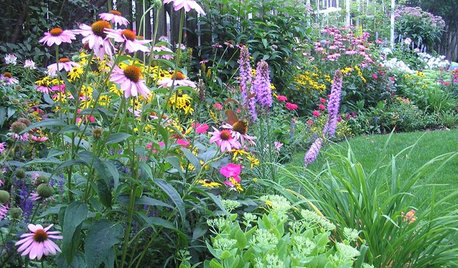Any benefit to Annual Rye Grass in regular lawn
User
12 years ago
Related Stories

GARDENING GUIDESSmall Gem Lawns: More Impact From Less Grass
Instead of letting the lawn sprawl, make it a shapely design element in your yard. You’ll reap benefits both practical and aesthetic
Full Story
GRASSESHow to Rock a Lawn
Weekend Project: The key to healthy grass begins with the soil. If turf works for you, here’s how to fix it and keep it looking its best
Full Story
LANDSCAPE DESIGN15 Great Ideas for a Lawn-Free Yard
End the turf war for good with hardscaping, native grasses and ground covers that save water and are easier to maintain
Full Story
LANDSCAPE DESIGNTry Slow Gardening for Some Unexpected Benefits
Why set your garden on the fast track? Here's how to relax and enjoy it in an entirely new way
Full Story
FLOORS5 Benefits to Concrete Floors for Everyday Living
Get low-maintenance home flooring that creates high impact and works with home styles from traditional to modern
Full Story
LANDSCAPE DESIGNIs It Time to Consider Fake Grass?
With more realistic-looking options than ever, synthetic turf can be a boon. Find the benefits and an installation how-to here
Full Story
GARDENING GUIDES10 Top California Native Plants, Trees and Grasses
Enjoy a fuss-free, water-wise garden in the Golden State by growing plants naturally in tune with the climate and wildlife
Full Story
GRASSES10 Ways to Use Ornamental Grasses in the Landscape
These low-maintenance plants can add beauty, texture and privacy to any size garden
Full Story
LANDSCAPE DESIGN7 Low-Maintenance Lawn Alternatives
Turf isn't the only ground cover in town. Get a lush no-grass lawn with clover, moss and other easy-care plants
Full Story
EARTH DAYThe Case for Losing the Traditional Lawn
Work less, help the environment and foster connections by just saying no to typical turf
Full Story





rhizo_1 (North AL) zone 7
rhizo_1 (North AL) zone 7
Related Professionals
Fort Lee Landscape Architects & Landscape Designers · Mount Wilson Landscape Architects & Landscape Designers · Milford Landscape Contractors · Matthews Landscape Contractors · Fishers Landscape Contractors · Galt Landscape Contractors · Hoover Landscape Contractors · Oxnard Landscape Contractors · Saint Paul Landscape Contractors · Teaneck Landscape Contractors · Waldorf Landscape Contractors · Aliso Viejo Siding & Exteriors · Dale City Siding & Exteriors · Madison Siding & Exteriors · Malden Siding & ExteriorsUserOriginal Author